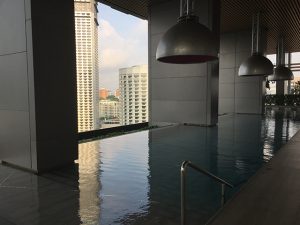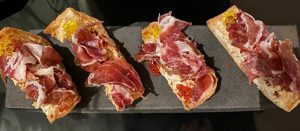In the time of Omicron – a visit to Singapore
Australians have found it seriously difficult to travel over the last couple of years, so when the opportunity for a visit to Singapore came up we jumped at it.
But travelling in the time of Omicron is not for the faint-hearted – especially to Singapore which has some stringent requirements. Singapore’s Vaccinated Travel Lane or VTL is open to a number of nations although, as I write this blog, sales of new air tickets from Australia have been paused.
Here’s our experience in travelling from Melbourne. You should check your own country’s requirements, as well as any your airline might have. As Omicron, or any other COVID-19 variant comes to the fore, the process may well change.
So, what did we need before getting on a plane? Here’s our checklist:
- Travel on a designated VTL flight. All Singapore Airlines, Qantas and Jetstar flights departing from the east coast of Australia currently fit the bill.
- Be fully vaccinated for COVID-19 (with an approved vaccine). Again, at the time of writing there was no requirement to have had a booster dose, so this means two jabs.
- Have a minimum amount of $30,000 in travel insurance which specifically covers COVID-19. I’ve provided a link below to the Changi Airport website which outlines approved insurance policies. Be aware that the cost is not uniform across providers and also varies depending on your age and other factors. Ours cost around S$30 each.
- Download your International COVID-19 Vaccine Certificate. Australians can access this through the Medicare App on their smartphones. An actual print-out of this certificate comes in very, very handy.
- Apply for the Singapore Vaccinated Travel Pass. This is a non-negotiable. Greedy Girl knows of a number of people who have fronted up to take their flight without this document and denied boarding. Applications are available between seven and 60 days of travel and there is no fee. You’ll need the number quoted on your pass many, many times during your stay.
- Undergo a PCR COVID-19 test within 72 hours of your departure and produce a document showing a negative result. We used the Histopath service at Melbourne airport (just near the Qantas domestic check-in) which was half the cost of other approved laboratories at the time of our trip. More on the testing later.
- Apply for a Singapore Arrival Card.
- Book and pay for a PCR test on arrival at Changi Airport.
- Download the Singapore TraceTogether app and populate it with as much information as is possible before your arrival.
Departing Australia
The direct Qantas flight from Melbourne to Singapore leaves around lunchtime and check-in opens four hours before departure. You must show all the evidence listed above (except for the proof of insurance and your test appointment on arrival at Changi).
The Histopath testing service at Melbourne advertises results within 90 minutes. At the same time as our trip, several Australian states also required negative PCR tests for domestic travellers. These lab services were literally run off their feet and timeframes ballooned. Our cause was helped immeasurably by a decision in late December by the lab to only accept international travellers.
We fronted up at the airport when the testing centre opened at 6am – giving us a 2.5 hour window to get results before check-in opened. There was no queue, the stick up the nose and down the throat was performed quickly, and off we went, masked up, to wait for the result.
It came just over an hour later. There is a separate small kiosk that prints out the result and certifies it ready for check-in. The joy of a negative test in hand should not be underestimated. We passed one forlorn chap on his phone, presumably to a testing laboratory, pleading for results, saying he’d been waiting two days.
Having priority access to check-in is definitely a bonus. Our agent was fairly new to the procedure, but commented that the process for Singapore is far and away the most complicated of any destination Qantas is currently able to service. All documents were checked and re-checked and there is a requirement to ensure your TraceTogether app is ready and working.
All told, the process took around 35 minutes – absolutely the longest time we’ve ever taken to check-in for a flight. Greedy Girl was seriously nostalgic for the days of app check-in and electronic boarding passes.
On board
Not much is different, except you’re required to keep your face mask fitted whenever you’re not eating or drinking. Flight attendants monitor this pretty closely.
The flight itself wasn’t particularly full and people were allowed to move to empty rows, that hadn’t been blocked off. On the way home, however, no-one was permitted to change seats with flight attendants saying this was a requirement of contact tracing. This caused a bit of consternation among some very cramped people in economy eyeing off empty rows but was rigorously enforced.
A further note about your return trip: Australia requires you to make a travel declaration and this is checked, along with your pre-departure PCR test and vaccination record, before you can check in to go home.
On arrival
Changi airport is a bit eerie at the moment. There are certainly no queues for anything. We fronted straight up to an immigration officer who processed our passports first with the obligatory thumbprint scanning and picture.
After then providing all the documents as above and showing we had the app installed, we were on our way – to the COVID testing facility.
Again, no queues and the test was performed with a minimum of fuss. Once you’ve ticked that box, you’re permitted to travel directly to your hotel via taxi or private car – the airport train is a no-no. You’re subject, at that point, to the ‘Stay Home Notice’ (SHN) and you must book a hotel that caters for both VTL and SHN passengers. A link to the current list of eligible hotels is provided at the end of this blog.
We headed for the JW Marriott South Beach, just across the road from the famed Raffles Hotel and quite close to City Hall MRT station.
The rules continue apace once you’re out of the airport. On checking in to the hotel, we had to go directly to our room and isolate until we could confirm a negative result from the arrival COVID test.
Even though we had booked a room with executive lounge access, we were not permitted to go in there to obtain any food/drinks. In my pre-arrival emails with the hotel, I asked what might be possible and the response was that we would be brought food and cocktails from the lounge to our room. All good!
So, about 10 minutes after settling into the room, the ‘spread’ arrived. Two cardboard boxes with cold food (admittedly some of it was not supposed to be warm, but a cold slider and satay stick isn’t particularly appetising), a small container of noodles in a spicy broth and two cans of Pepsi were put forward. Quite frankly, it was depressing. There was also no cutlery or napkins provided. We were forced to slurp the noodles directly from the polystyrene cup.
Greedy Girl is very partial to a cocktail, particularly a Margarita, or Cosmopolitan, or even a Singapore Sling. Note to the hotel: Pepsi is not a cocktail. Gluttonous husband – a little tired and grumpy by this point, asked for a beer. No can do was the answer, as the beer in the lounge was not packaged.
But when there’s a will there’s a way – we persisted and two takeaway coffee cups were brought up a little later, both containing ice-cold Tiger Beer. Gluttonous husband was immediately revived.
Life in Singapore
Our negative results came through on email as we slept. We forwarded confirmation to the front desk and were on our way.
The hotel requires you to pre-book your breakfast and pool stay through an app. That was easy enough, although it wasn’t until we presented ourselves at the very impressive-looking pool on the 18th floor that we were informed the booking was only required to manage numbers among swimmers. There were plenty of spots to enjoy sitting and taking in the relatively cool “winter” air – essentially temperatures in the high 20s (celsius) and lower than usual humidity that were available at any time we liked.
And from the moment you’re set free, the further testing requirements kick in. You need to get a Rapid Antigen Test kit and self-test pretty much every day you’re in Singapore. Luckily, these are plentiful and available from convenience stores, vending machines and pharmacies. You’re sent an email every day outlining the requirement and providing the link for you to report the result.
On day 3 and 7 of your stay, you’re required to book an appointment for a supervised RAT at a cost of S$15 per person. The government websites have an exhaustive list of places this is possible, but be aware that if you’re there during a public holiday, your options are much more limited.
We were there over New Year and faced very few options for our first supervised RAT. We ended up at the People’s Park Food Centre, near Chinatown.
If your experience/image of Singapore is gleaming, pristine, air-conditioned shopping malls, restaurants and hotels, People’s Park will be a shock to the system. It was incredibly crowded, even at late afternoon, with lots of dirty tables. Social distancing is absolutely non-existent and the facility is open air, so it’s hot and humid. For our second supervised RAT we were able to use a pop-up facility at the Swissotel the Stamford, accessed via Raffles City shopping mall. The queues were much shorter and the joy of air-conditioning was a real bonus.
Within 72 hours of your departure, most countries/airlines require another negative PCR test. This can get very expensive, especially if you’re looking for an ‘express’ service where costs run to around S$300 per test. We booked at the Nuffield Medical Centre at Orchard but there are lots of providers – simply Google for a location convenient for you.
The TraceTogether App
You have to check in everywhere in Singapore, including for us at the hotel, when we went to breakfast or visited the executive club lounge.
If, like us, you don’t have international data roaming on your phone, a great many places have free wi-fi you can use to scan the QR codes. Most shopping centres and bigger facilities also have a nifty little gadget at their security entry points that work with Bluetooth.
Often you’ll be asked to proof your vaccination status as you enter venues. There is a spot in the TraceTogether App that demonstrates this. Forget about showing the Australian certificate or anything else. It’s more than likely not to be accepted.
Eating and drinking
Most restaurants seem to be open. Watch out for a forthcoming blog for our review of the new Burnt Ends, which has moved out of Chinatown to Dempsey Village.
Food in Singapore remains an absolute highlight. While the offerings in the JW Marriott executive lounge were a bit disappointing (it’s all pre-plated and served to you), other spots we went for food were reasonable. One that was more than reasonable was a catch-up with a friend at the Fairmont Hotel’s AntiDote bar where the glass of Laurent Perrier champagne at S$19 is most likely the cheapest deal you’ll find in Singapore.
The bar snacks there also go beyond the mundane. Fries come with a delectable curry mayo and this ham ‘toast’ was sublime:
One thing we weren’t aware of, and caused a bit of a sour taste in our mouths was that, currently, alcohol service in restaurants in Singapore must cease at 10:30pm. We went out for a New Year’s Eve dinner not knowing this and were both annoyed and deflated when wait staff literally wanted to snatch our glass out of our hand. Happy New Year to us, not. Still, rules are rules. It would be nice for establishments to communicate those at the time of booking, or if the scenario changes, to update patrons. ‘Nuff said.
Singapore is a place where people assiduously follow the rules. We weren’t required to provide proof of our negative self-administered RATs (apart from making the online acknowledgment) but we photographed the results and kept them – just in case. We even got used to having to wear a mask the moment we emerged from our hotel room. You can only take it off while you’re seated to eat or drink.
So, was it all worth it? The forms, the regulations, the check-ins, the masks, the tests (which, for a week’s stay, including the requirements for leaving Australia and coming back in cost around $700 for the two of us) didn’t derail our stay but it was definitely a downside. There’s the constant anxiety about testing positive and the possibility of being transferred to a healthcare facility or not being able to fly home.
Still, if we had the opportunity to do this again, we certainly would. Our next trip is planned for May 2022 – and Greedy Girl has everything crossed that the process won’t be as onerous, but who knows where this pandemic is going to take us next?
Handy links
Preflight PCR testing – Australia








Comments